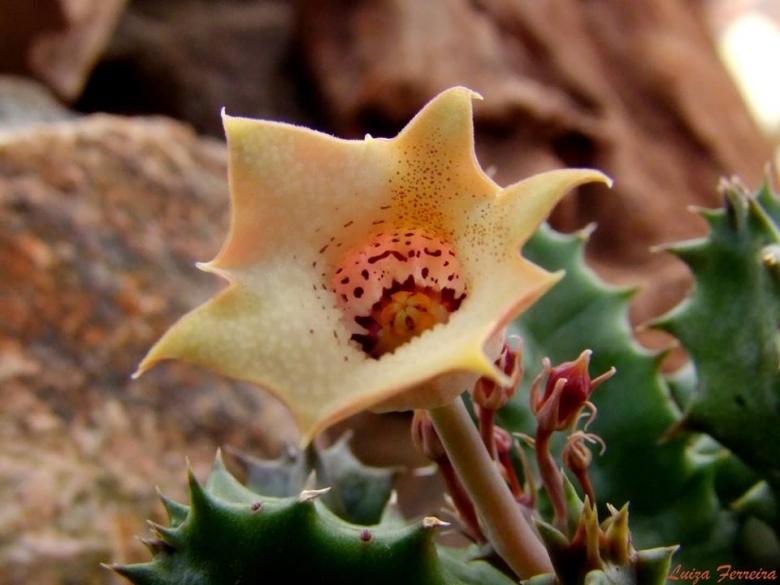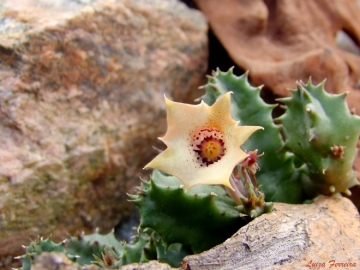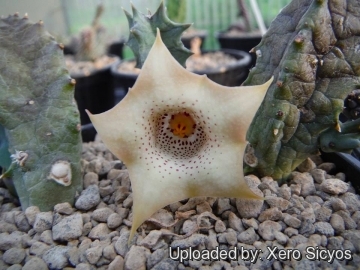




Your support is critical to our success.
Stapelieae (White & Sloane) ed. 2 3: 885 1937
Family: ASCLEPIADACEAE

Origin and Habitat: Limpopo, Mpumalanga, South Africa. Widespread between the Waterberg, Lephalale and Groblersdal.
Altitude range: 1000-1250 metres above sea level.
Habitat and Ecology: Huernia quintaSN|30725]]SN|30725]] grows on shallow soils in sandstone and granite outcrops in savannah and in Dolomite, north facing slopes.
Synonyms:
- Huernia quinta (E.Phillips) A.C.White & B.Sloane
- Huernia scabra var. quinta E.Phillips
Huernia quinta (E.Phillips) A.C.White & B.Sloane
Stapelieae (White & Sloane) ed. 2 3: 885 1937
Synonymy: 2
- Huernia quinta (E.Phillips) A.C.White & B.Sloane
- Huernia scabra var. quinta E.Phillips
Huernia quinta var. blyderiverensis L.C.Leach
Excelsa Taxon. Ser. 4: 178 (1988)
Synonymy: 2
- Huernia quinta var. blyderiverensis L.C.Leach
- Huernia blyderiverensis (L.C.Leach) Bruyns
Description: Huernia quintaSN|30725]]SN|30725]] is a variable succulent species with a tuft-like growth-form that grows to an average height of 7 cm. The flowers, which arise in groups of 4 or 5 from stem bases are attractively marked, creamy white, banded with dark red and with similar colouring on the reverse.
Derivation of specific name: This spaces was originally named “quinta” (= fifth) for the five rings of spots decorating the corolla of the type specimen.
Stems: 4-(or 5)-angled, erect or ascending, often slightly twisted, grey-green, rather thick 7 cm tall, and about 2 cm in diameter, the persistent tubercles along the stem-angles end in a sharp dirty creamy white thorn up to 4 mm long.
Leaves: Rudimentary, firm, whitish and persisting.
Flowers: 4–5 together at the lower part of the young stems. Flower stem less than 2 cm long. Sepals 5 x 1.5 mm. Corolla broadly bell-shaped, facing up, 20-35 nm in diameter (usually about 28-30 mm broad), creamy white, purple-mottled. Tube 7-10 mm cross, slightly pentagonal, papillous with red bands. Corolla-lobes triangular, flattened out widely, yellowish white and papillous, with 5 short tips. The intermediate tips are clearly developed. The papillae are flattened conical or hemispherical, sometimes covered with a 1 mm long bristle. The corona is cream to light brown, sometimes with brown spots, 3-4 mm in diameter and 4-5 mm high. The interstaminal lobes are notched or shortly toothed. The staminal corona lobes are approximately 1 mm wide with a blunt end. They meet on the stylus head. The surface is covered with very fine, blunted warts. The style head is conical and has a basal transverse furrow. The pollinia are brownish with a darker zone.
Blooming season: Flowering time is October-January.
Related species: Huernia quinta, near endemic to the Wolkberg-Waterberg Centre, is most closely related to Huernia nouhuysii and Huernia quintaSN|30725]]SN|30725]] var. blyderiverensis endemic to this centre too.
Subspecies, varieties, forms and cultivars of plants belonging to the Huernia quinta group
 Huernia quinta (E.Phillips) A.C.White & B.Sloane: Corolla broadly bell-shaped, up to 2,8 cm Ø, creamy-white banded with dark red. Lobes with bristle tipped papillae. Distribution: Limpopo, Mpumalanga, South Africa.
Huernia quinta (E.Phillips) A.C.White & B.Sloane: Corolla broadly bell-shaped, up to 2,8 cm Ø, creamy-white banded with dark red. Lobes with bristle tipped papillae. Distribution: Limpopo, Mpumalanga, South Africa.  Huernia quinta var. blyderiverensis L.C.Leach: has a spotted (not transversely striped) larger corolla with papillae not bristle-tipped and the mouth of the tube is more constricted. Distribution: Limpopo, Mpumalanga, South Africa.
Huernia quinta var. blyderiverensis L.C.Leach: has a spotted (not transversely striped) larger corolla with papillae not bristle-tipped and the mouth of the tube is more constricted. Distribution: Limpopo, Mpumalanga, South Africa.
Bibliography: Major references and further lectures
1) David Hardy, Anita Fabian, Gerrit Germishuizen “Succulents of the Transvaal” Southern Book Publishers, 1992
2) Werner Rauh “The Wonderful World of Succulents: Cultivation and Description of Selected Succulent Plants Other Than Cacti” Smithsonian Institution Press, 1984
3) Bruyns, P.V. 2005. "Stapeliads of southern Africa and Madagascar." (Vol. 1, pp. 1-330). Umdaus Press, Pretoria.
4) Foden, W. & Potter, L. 2009. "Huernia quinta (E.Phillips) A.C.White & B.Sloane." National Assessment: Red List of South African Plants version 2014.1. Accessed on 2015/03/09
5) Fl. Pl. South Africa 12: t.444 (1932).
6) Excelsa Taxon. Ser. 4: 177-179 (1988).
7) List South. African Succ. Pl. : 26 (1997).
8) Norbert Hahn “Endemic flora of the Soutpansberg” November 2002
9) Alain Campbell White und Boyd L. Sloane "The Stapelieae", volume 3. pp.819-1184, Pasadena, Calif., 1937
10) ocke Albers, Ulrich Mev “Illustrated Handbook of Succulent Plants: Asclepiadaceae” Springer Science & Business Media, 06 December 2012

Huernia quinta Photo by: Luiza Ferreira

Huernia quinta Photo by: Xero Sicyos
Cultivation and Propagation: Huernia quintaSN|30725]]SN|30725]] is an easily grown stapeliad, suited to hanging baskets as well as pots. It grow well in light gritty soil with a very liberal drainage. They should at all times sparingly watered (best rain water with some occasional fertiliser), and in winter time they hardly require any. They require outdoor culture, or a warm close greenhouse, while growing in the early part of summer, and afterwards may be ripened and kept in a greenhouse; but as they bloom chiefly in autumn, warmth is desirable to enable them to expand their flowers. They are also most attractive in a hanging pot with their trailing segments With numerous fleshy (non-hurtful) teeth. Some collectors enjoy the long, snake-like stems induced by an excess of water.
Spring: When winter ends and they begin to grow again, they will require much water and soaking the pots will no longer put the plants at risk for rot. In the spring they will grow well in partial shade and leaving them out in the rain may provide them with the water they need.
Summer: In the summer months they will tolerate heavy rain, but will be just as happy if the season is dry. It's best to sort out the stems while the plants are resting in the summer before they begin their autumnal growth cycle. They will tolerate very hot weather outdoors as long as they are kept in filtered light and this will encourage them to flower in the Autumn. They also enjoy some fertiliser. Moving the plants as they are developing buds may cause them to spontaneously abort the flowers all together.
Autumn: In the fall keep them outdoors until the night time temperatures drop below the 5°C.
Winter: Winter care presents no problems at 5°-10° C with plenty of light. As soon as they are flowered be sure to take extra precautions to keep them dry, because damp cool conditions when the plants are resting is an invitation to fungal infections, but - according to temperatures –some occasional lit watering may be useful.
Potting medium: Since roots are quite shallow, use a cactus mix or add extra perlite or pumice to regular soil potting soil. A gritty, very free-draining compost is suitable, and clay pots help the plants to dry out between watering. Re-pot every 2 years.
Pest and diseases: Huernia are generally fairly easy to grow, especially if kept pest-free. They are very susceptible to stem and root mealy bugs, and damage from these may well initiate fungal attack. Any time when there is a dead or dying stem in the pot it is important to remove it immediately and completely before other healthy stems can become ill too, isolate the healthy parts, dry them off, and re-root them in new compost.
Propagation: Easiest with stem cuttings. Allow cuttings to dry a day before planting. Stems must be laid (Not buried) on gritty compost and will then root from the underside of the stems. It can also be increased from seeds sowing in spring in moist, sandy peat moss. Barely cover seeds. Seeds germinate quickly. In any season it's best to lay the stems out for several days before replanting them and then pot them only in dry soil and withhold any water until they begin to shrivel or start growing again.
| Your Actions | |
|---|---|
| Back to Huernia index | |
| Back to Asclepiadaceae index | |
 |
Back to Succulents Encyclopedia index |
Privacy stantement - Terms and conditions - How to cite - About us - Feedback - Donate



